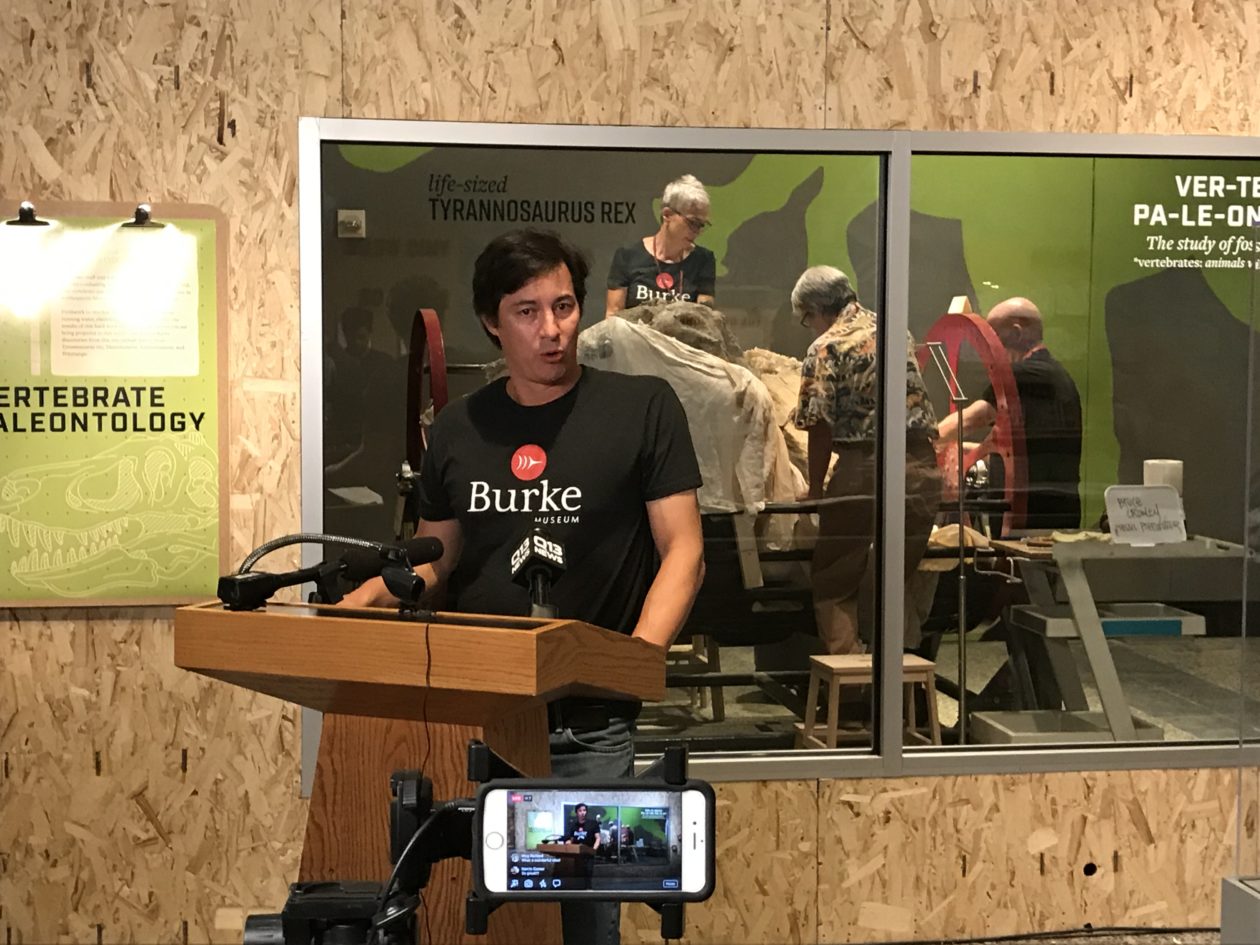
The only Tyrannosaurus rex skull to go on public display in Washington state is getting its unveiling at Seattle’s Burke Museum of Natural History and Culture – and the best part is that you can watch as more and more of the skull is revealed.
“You can see those teeth coming out,” University of Washington biologist Greg Wilson, the museum’s curator of vertebrate paleontology, told GeekWire today at the big reveal. “And those teeth are gorgeous.”
As he spoke, a team of paleontologists and trained volunteers worked methodically in a glassed-in room, chipping at and brushing away the rock and sand that surrounded the fossil skull.
The 4-foot-long specimen, which weighed well more than 3,000 pounds in its protective plaster jacket, was delivered to the museum on the UW campus a year ago. Since then, the team has cleaned up a T. rex rib and the jawbone that was found accompanying the skull.
To facilitate the biggest part of the job, the team mounted the plaster-covered skull on a huge, wheel-equipped device they call the “T. rex rotisserie rack,” or TR3.
“We custom-built it to handle a jacket of this size, to rotate the sample,” Wilson said.
So far, paleontologists have removed the plaster and much of the surrounding rock from the top right part of the fossilized skull. It will take months more for the rest of the skull to come to light.
More than a dozen scientists and volunteers will take turns removing the rock and sand. On most days, visitors to the Burke Museum will be able to look through the glass and watch the team at work in a part of the museum called “Testing, Testing 1-2-3.”
- Burke Museum paleontologists remove rock surrounding the ribs of a T. rex. (Burke Museum Photo / Larry Mose)
- Paleontologists prepare to remove the T. rex skull from the dig site in northern Montana and transport it to the Burke Museum. (Burke Museum Photo / Dave DeMar)
- University of Washington biologist Greg Wilson, the Burke Museum’s curator of vertebrate paleontology, leads UW students to the “Tufts-Love” T. rex dig site. (UW Photo / Mark Stone)
- Workers unload a plaster-wrapped T. rex skull at Seattle’s Burke Museum in August 2016. (GeekWire photo by Alan Boyle)
- Paleontologists lower the “Tufts-Love Rex” skull into its rack. (UW Photo / Mark Stone)
- Paleontology team member Ben LeFebvre scratches away at the sand covering the fossilized T. rex skull. (GeekWire Photo / Alan Boyle)
- T. rex teeth can be seen after rock has been removed from the bone. (Burke Museum Photo)
- Biologist Greg Wilson introduces the T. rex exhibit at the Burke Museum while a paleontology team works in the background.
- The T. rex jaw shows signs that the dinosaur was chomped by another T. rex, but that the wounds healed. (GeekWire Photo / Alan Boyle)
- A T. rex rib bone is on display at the Burke Museum. (GeekWire Photo / Alan Boyle)
Wilson said it looks as if the individual bones that make up the skull are still connected, or articulated, which should make the job easier for the preservation team.
The first traces of the 66 million-year-old fossil were found in Montana’s Hell Creek Formation in 2015 by two volunteer fossil hunters, Jason Love and Luke Tufts. In their honor, the skull and other bones associated with it have been dubbed the Tufts-Love Rex.
“I’m just happy that it’s here, and that kids can see it,” Love told GeekWire at the museum. Tufts marveled at how expertly the museum’s paleontologists are freeing the skull from the surrounding rock. “It’s like a dream,” Tufts said.
Scores of bones – including a shoulder blade, a part of the lower jaw and what appears to be an arm bone – were added to the collection during this summer’s field season.
The total now amounts to about 90 bones, making up roughly 30 percent of the full skeleton. Wilson said that would rank the Tufts-Love Rex among the 10 most complete T. rex skeletons ever discovered.
The dinosaur’s dimensions appear to be about 85 percent the size of the largest T. rex found to date. In life, it would have been nearly as tall as a city bus at the hips, and would have measured about the length of a bus from nose to tail.
The Tufts-Love Rex is thought to have been about 15 years old when it died, or about halfway through the typical T. rex lifespan of 25 to 30 years. But so far, there’s no evidence that could determine whether it was male or female.
Wilson expects the skull and other parts of the skeleton to be in their final shape for permanent display by 2019, when the $82.5 million New Burke Museum is expected to open next to the museum’s current site.
“Testing, Testing 1-2-3,” the Burke Museum exhibit that lets visitors watch the preparation of the T. rex skull, has its grand opening on Aug. 12. Members of the fossil preparation and excavation crews will give talks about the dinosaur at 11 a.m., 12:30 p.m. and 2 p.m. PT on Aug. 12 and 13. There’ll also be dinosaur crafts and activities for kids of all ages.













